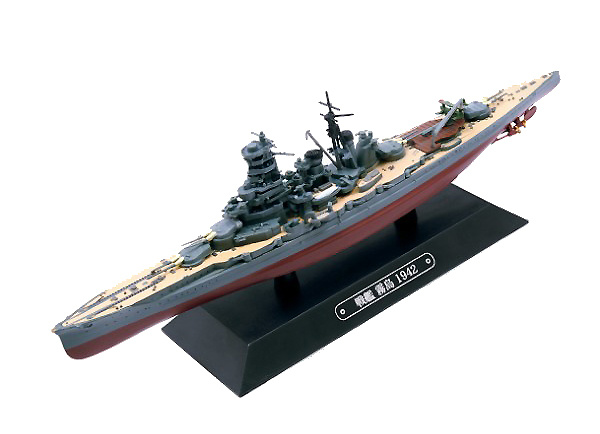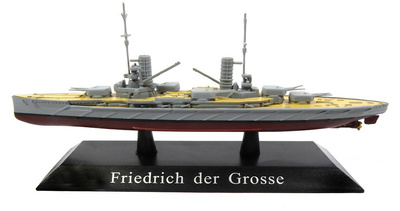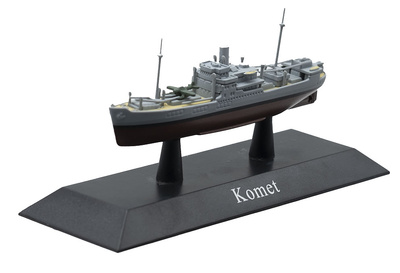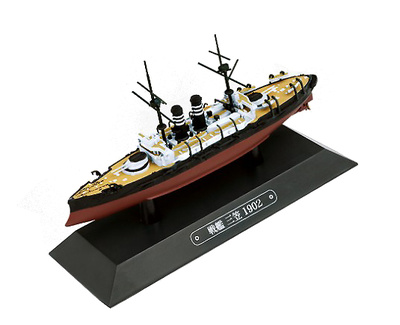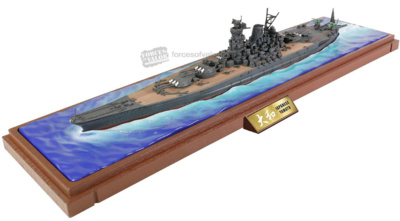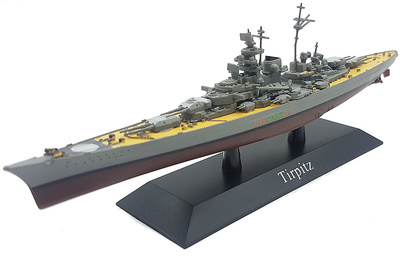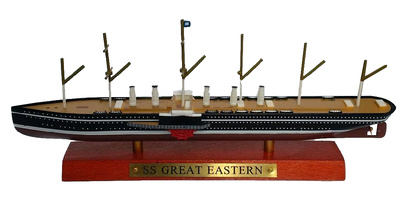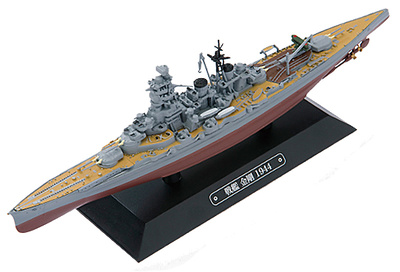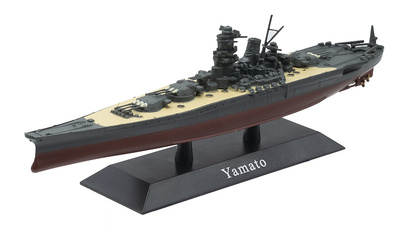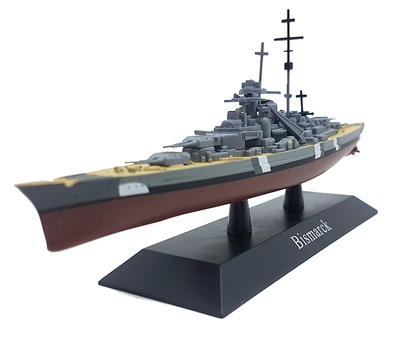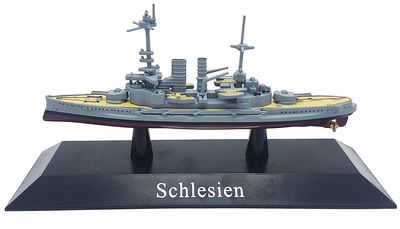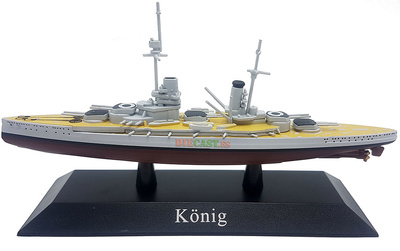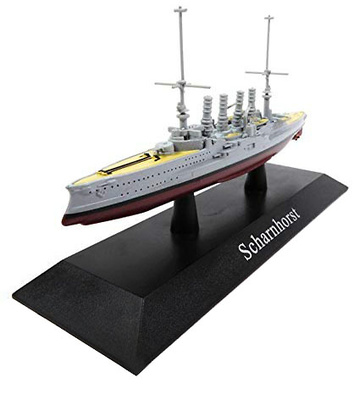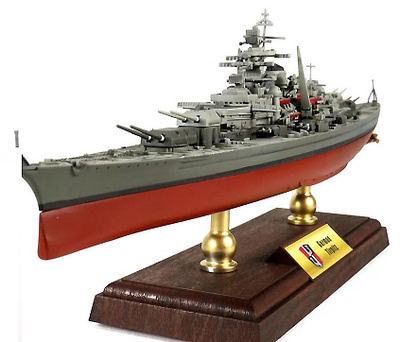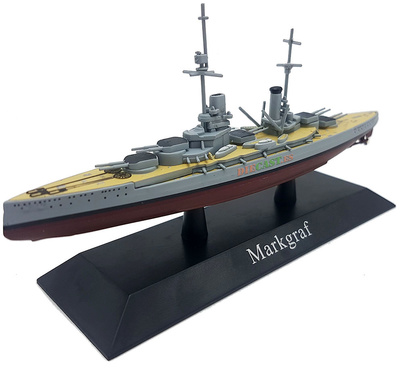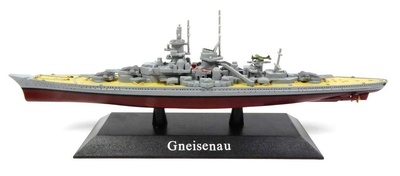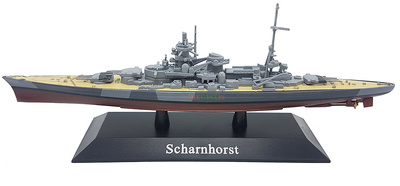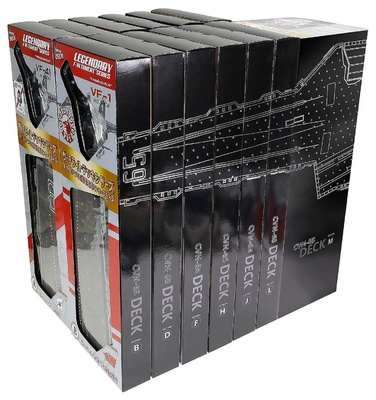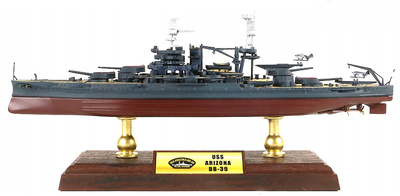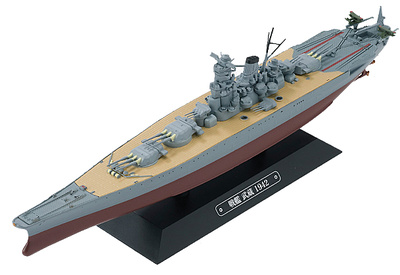Japanese battleship Kirishima, 1942, 1: 1100, Eaglemoss
Brand: Eaglemoss
Scale 1: 1,100
Original ref: EMOS7
| Prices with VAT included | ||
apanese battleship Kirishima, 1942, 1: 1100, Eaglemoss
1: 1100 scale
Length Approx: 20.00 cm.
Total height Approx: 7.00 cm.
Manufacture diecast, metal with plastic accessories.
Assembled and painted by hand with original decorations.
Includes base with the Japanese name of the battleship (see photo).
HISTORY
The Kirishima was a battleship of the Kongō class belonging to the Imperial Japanese Navy. He was the third member of his class actively participating in the first phase of the Pacific front, during World War II. Initially it was assigned to operations in waters of China and Korea.
The Kirishima was built by the Mitsubishi company; his helmet was launched on March 17, 1912, completed on December 1, 1913 and commissioned on April 19, 1915. Between 1927 and 1930 his first modification was made, among which was the addition of anti-torpedo bulges, an increase in horizontal armor, change of chimney configuration and reconstruction of the bridge to a pagoda-type mast, typical of Japanese design. These modifications were extended to the entire Kongō class.
In 1932, he participated in the so-called Manchuria Incident. From 1933 to 1934 it was modified at the Kure naval base; catapults were added for reconnaissance seaplanes type Nakajima E8N; being classified as a fast warship, increasing its tonnage by 4,000 tons. In the interwar period it remained in the waters of China during the Second Sino-Japanese War.
In the preamble of the opening of the Pacific front, during World War II, he was assigned to the Combined Fleet. During the attack on Pearl Harbor on December 7, 1941, their planes were used in aerial reconnaissance prior to the attack.
He participated in different warlike scenarios of the Pacific, giving coverage in several amphibious operations during the Japanese territorial expansion. On March 1, 1942, along with the twin battleship Hiei, they sank the American light cruiser USS Edsall (DD-219) into the Java Sea. During the Battle of Midway in June 1942, it was the closest heavy unit to the attack force and gave anti-aircraft coverage to the Akagi aircraft carrier when it was bombed by US B-17 aircraft. In that same action he prepared to tow the burning Hiryu aircraft carrier, but this order was canceled by Admiral Chuichi Nagumo. He participated in August of that same year in the Battle of the Eastern Solomon and in the following month in the Battle of the Santa Cruz Islands.
On November 15, 1942, during the second Naval Battle of Guadalcanal, operating against the US fleet, he was surprised by the USS Washington, when he was holding an artillery duel with the battleship USS South Dakota. The US-led radar fire proved very effective and fatally damaged the Kirishima by leaving it out of control. Captain Sanji Iwabuchi ordered the abandonment of the ship, the crew being transferred to a destroyer; subsequently ordering the opening of the battleship valves. The Kirishima finally went down, turning northwest of the island of Savo, not far from where his twin battleship, the battleship Hiei had been sunk two days before, in the first action in this war scenario.
In 1992, Dr. Robert Ballard discovered it when he explored the so-called Bay of the Iron Fund in the immmediations of the island of Savo, more than 1100 m deep, completely turned.
source: Wikipeida
-
No reviews have been registered yet about this article
Purchase guarantee
We answer phone inquiries from 9:00 a.m. to 1:00 p.m., Monday through Friday.
For your convenience, you can send your inquiries via our email address info@diecast.es, which is answered during extended business hours.
All products offered in our store are guaranteed against breakage or damage occurring during shipping or obvious manufacturing defects, and, where applicable, are guaranteed by each manufacturer or by current legislation. We take special care to ensure that our products are backed by renowned manufacturers and a high level of quality, as well as a carefully packaged process.
The guarantee is effective through a refund of the amount paid or a replacement of the model, although the latter is not always possible as it depends on the availability of units at any given time or the type of defect the model presents.
Money Back Guarantee
If for any reason you are not satisfied with your purchased product, you have 14 days from the date of delivery to return it. In this case, the shipping and collection costs will be borne by the customer. Before making the return, the customer must contact our sales department within the indicated period by email, phone, or fax, where they will be informed of the return process. Any return without prior notification will not be accepted. To accept the return, both the product and its packaging must be in perfect condition, free of scratches, broken, or damaged packaging, and must include all documentation accompanying the product and its accessories. The customer must ensure proper packaging to ensure its transport without damage. Once received and verified by our staff that the product is in the same condition as when it was shipped, the refund will be processed as previously agreed with the customer.
Additional Terms
Diecast.es reserves the right to process orders placed through its website. Placing an order does not imply acceptance of the order, in whole or in part. Diecast.es may unilaterally cancel the customer's account and the order placed. The prices indicated are valid except for errors or omissions and do not constitute a contractual obligation on the part of Diecast.es. In the event of an upward price variation due to an error, the customer will be notified before placing the order for their approval.
The photographs of the models shown on our website, as well as the information shown on each item's listing, are for informational purposes only and do not constitute a contractual obligation on the part of Diecast.es. If you detect any errors, please notify us so that we can correct them.

Battleship SMS Friedrich der Grosse, Kaiserliche Marine, 1911, 1: 1250, DeAgostini
Brand: DeAgostini
Scale 1: 1250
Rfa. original: KS41
Collection: Kriegsschiffe more...OUT OF STOCK
Auxiliary Cruise Komet, Kriegsmarine, 1940, 1: 1250, DeAgostini
Brand: DeAgostini
Scale 1: 1250
Rfa. original: KS612
Collection: Kriegsschiffe more...OUT OF STOCK
Japanese Battleship Mikasa, 1902, 1: 1100, Eaglemoss
Brand: Eaglemoss
more...
1: 1100 scale
Original ref: EMOS85,90€Yamato Cruise, Imperial Japanese Navy, 1940-1945, 1: 700, Forces of Valor
Brand: Forces of Valor
Scale 1: 700
Rfa. Original: 862012a more...82,00€- 38
Battleship Tirpitz, Kriegsmarine, 1941, 1: 1250, DeAgostini
Brand: DeAgostini
Scale 1: 1250
Original ref: KS12
Collection: Kriegsschiffe more...9,50€ 5,90€ Transatlantic Great Eastern, Great Britain, 1860, 1: 1250, Atlas
Brand: Atlas
Scale 1: 1250
Original ref: 7572008 more...9,90€Japanese Kongo Cruise, 1912-44, 1: 1100, Eaglemoss
Brand: Eaglemoss
Scale 1: 1,100
Original ref: EMOS5
more...11,90€- 19
Battleship Yamato, Imperial Japanese Navy, 1941, 1: 1250, DeAgostini
Brand: DeAgostini
Scale 1: 1250
Original ref: KS04
Collection: Kriegsschiffe more...8,50€ 6,90€ Battleship Bismarck, Kriegsmarine, 1939, 1:1250, DeAgostini
Brand: DeAgostini
Scale 1: 1250
Original ref: KS01
Collection: Kriegsschiffe
more...8,50€- 42
Battleship Schlesien, Kaiserliche Marine, 1908, 1: 1250, DeAgostini
Brand: DeAgostini
Scale 1: 1250
Original ref: KS25
Collection: Kriegsschiffe
more...8,50€ 4,90€ - 48
Battleship Konig, Kaiserliche Marine, 1914, 1: 1250, DeAgostini
Brand: DeAgostini
Scale 1: 1250
Original ref: KS18
Collection: Kriegsschiffe more...9,50€ 4,90€ Armored Cruiser Scharnhorst, Kriegsmarine, 1907, 1: 1250, DeAgostini
Brand: DeAgostini
Scale 1: 1250
Rfa. original: KS42
Collection: Kriegsschiffe more...OUT OF STOCK
Battleship Tirpitz, Kriegsmarine, Norwegian Operation, 1942, 1:700, Forces of Valor
Brand: Forces of Valor
Scale 1: 700
Rfa. Original: 861005a more...75,00€Battleship Markgraf, Kaiserliche Marine, 1914, 1: 1250, DeAgostini
Brand: DeAgostini
Scale 1: 1250
Rfa. original: KS37
Collection: Kriegsschiffe more...8,30€- 24
Warship Gneisenau, 1: 1250, DeAgostini
Brand: DeAgostini
Scale 1: 1250
Original ref: KS05
Collection: Kriegsschiffe more...8,50€ 6,50€ Battleship Scharnhorst, Kriegsmarine, 1939, 1: 1250, DeAgostini
Brand: DeAgostini
Scale 1: 1250
Original ref: KS02
Collection: Kriegsschiffe
more...8,50€CNV-65 Enterprise Aircraft Carrier Bridge, 1:200, Forces of Valor
Brand: Forces of Valor
Scale 1:200
Ref: CNV-65 more...399,00€Battleship USS Arizona BB-39, Pearl Harbor, 1941, 1: 700, Forces of Valor
Manufacturer: Unimax
Brand: Forces of Valor
1: 700 scale
Rfa. Original: 861008A more...77,00€Japanese Battleship Musashi, 1940-44, 1: 1100, Eaglemoss
Brand: Eaglemoss
Scale 1: 1,100
Original ref: EMOS4
more...5,90€
Returns
If for any reason you are not satisfied with your product purchased through the Internet, you have a period of 15 days, from the date of delivery of the product, to return it. In this case the shipping and collection costs will be borne by the customer. Before making such return, the client must contact us within the indicated period via email, telephone or fax where the return process will be indicated. Any return without this prior communication will not be accepted. To be able to accept the return must be both the product and its packaging, in perfect condition, without scratches or broken or damaged packaging and including all documentation accompanying the product and its accessories. The customer must make a proper packaging to ensure transport without damage. Once received and verified by our staff that the product is in the same state in which it was sent, the amount will be refunded according to the payment method made by the customer. Any refund will be deducted in a deduction in the amount of 8% for reception, inspection and demerit costs.
Battleship USS Arizona BB-39, Pearl Harbor, 1941, 1: 700, Forces of Valor
Manufacturer: Unimax
Brand: Forces of Valor
1: 700 scale
Rfa. Original: 861008A more...77,00€- 42
Battleship Schlesien, Kaiserliche Marine, 1908, 1: 1250, DeAgostini
Brand: DeAgostini
Scale 1: 1250
Original ref: KS25
Collection: Kriegsschiffe
more...8,50€ 4,90€ - 24
Warship Gneisenau, 1: 1250, DeAgostini
Brand: DeAgostini
Scale 1: 1250
Original ref: KS05
Collection: Kriegsschiffe more...8,50€ 6,50€ - 48
Battleship Konig, Kaiserliche Marine, 1914, 1: 1250, DeAgostini
Brand: DeAgostini
Scale 1: 1250
Original ref: KS18
Collection: Kriegsschiffe more...9,50€ 4,90€ - 19
Battleship Yamato, Imperial Japanese Navy, 1941, 1: 1250, DeAgostini
Brand: DeAgostini
Scale 1: 1250
Original ref: KS04
Collection: Kriegsschiffe more...8,50€ 6,90€ Auxiliary Cruise Komet, Kriegsmarine, 1940, 1: 1250, DeAgostini
Brand: DeAgostini
Scale 1: 1250
Rfa. original: KS612
Collection: Kriegsschiffe more...OUT OF STOCK
Yamato Cruise, Imperial Japanese Navy, 1940-1945, 1: 700, Forces of Valor
Brand: Forces of Valor
Scale 1: 700
Rfa. Original: 862012a more...82,00€Japanese Battleship Musashi, 1940-44, 1: 1100, Eaglemoss
Brand: Eaglemoss
Scale 1: 1,100
Original ref: EMOS4
more...5,90€

